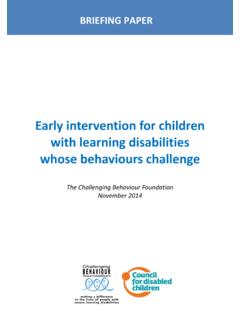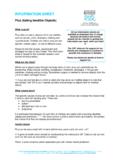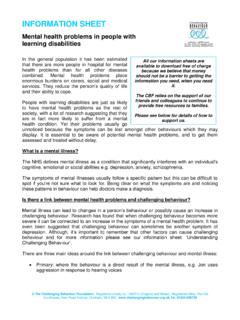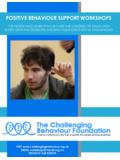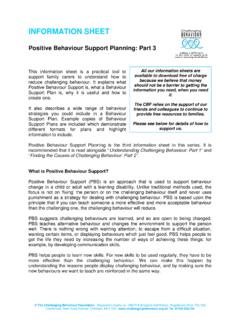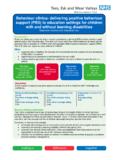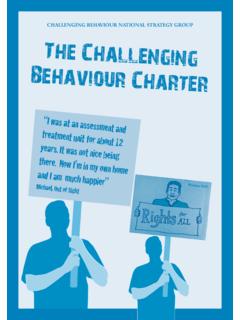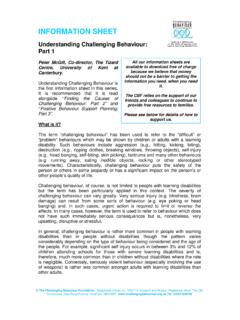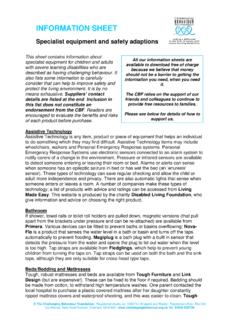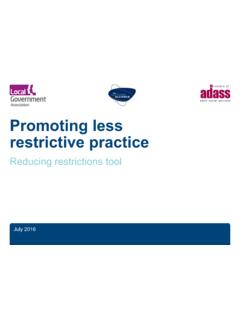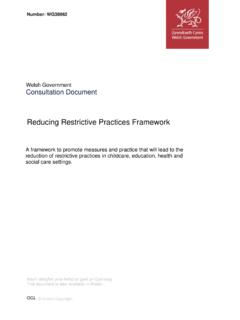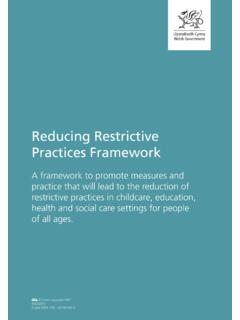Transcription of Reducing the use of restraint, seclusion and other ...
1 The Challenging Behaviour Foundation. Tel. 01634 838739 Registered charity no. 1060714. Registered office: The Old Courthouse, New Road Avenue, Chatham, ME4 6BE. 1 010 INFORMATION SHEET Reducing the use of restraint, seclusion and other restrictive practices Responding to challenging behaviour Behaviours that challenge can be stressful, upsetting and pose risks to the person with a learning disability and to those who provide their care and support. A good behaviour support plan gives families and staff a set of strategies to use that help reduce these risks when challenging behaviours occur, along with many more strategies to help people behave in non-challenging ways.
2 One of the best ways to reduce the risks associated with challenging behaviours is to support the person to learn an alternative way of communicating or a new skill instead. The terms Proactive (or GREEN) Strategies and De-escalation (or AMBER) Strategies are often used to describe the things we can do to prevent challenging behaviours happening in the first place. Examples are provided in the table overleaf. All our information sheets are available to download free of charge. To enable us to continue our work please support us or donate 3 by texting CBF to 70450. Is this resource helpful? Please spend a few minutes giving us some feedback: The Challenging Behaviour Foundation.
3 Tel. 01634 838739 Registered charity no. 1060714. Registered office: The Old Courthouse, New Road Avenue, Chatham, ME4 6BE. 2 010 Proactive (or GREEN) Strategies De-escalation (or AMBER) Strategies Used to: Help the person stay calm and happy Used to: Restore calm if the person starts to show early warning signs of distress or challenging behaviour May include: Making changes to a person s environment so that the possibility of challenging behaviour is reduced Teaching the person new skills so that they no longer have to use challenging behaviour to get their needs met May include: Removing any known triggers, including activities, things and carer s actions or demands Diverting the person to an activity or situation they enjoy and will take their mind off whatever is causing them distress Example: Joe knows that Lucy can become agitated during car journeys when he takes a different route to usual, so he makes sure that he drives the same route whenever possible to reduce the chance of her becoming upset.
4 Example: Lucy starts to become agitated during a car journey because her usual route is closed because of road works. Joe sings silly songs as this usually distracts Lucy when she starts to become anxious. These strategies are described in more detail in the Positive Behaviour Support Planning information sheet. Unfortunately, it is not always possible to control triggers and keep someone happy and calm, so challenging behaviours may occur, even when everything has been done to try to prevent the person from becoming distressed. When this does happen, families and support staff will need to make sure that the person and those around them are kept safe.
5 The ways that we react to behaviours that challenge need to be as well planned and thought about as the proactive strategies described above, so everyone who supports the person knows what to do. Reactive Strategies The strategies that are used when a person is behaving in a challenging way are called Reactive (or RED) Strategies . These can range from increasing someone s personal space to physically restraining them. The remainder of this information sheet will provide you with information about responses to challenging behaviour including: physical restraint, seclusion and mechanical restraint. The Challenging Behaviour Foundation. Tel.
6 01634 838739 Registered charity no. 1060714. Registered office: The Old Courthouse, New Road Avenue, Chatham, ME4 6BE. 3 010 Reactive strategies, as their name suggests, are used once challenging behaviours occur and provide carers with clear plans for how to respond when they do. These strategies will not lead to any future change in the pattern of a person's behaviour; their goal is to keep everyone safe. Because they do not help the person learn or develop skills, reactive strategies must never be the only support or intervention planned for someone with a learning disability, but should be used as part of an overall positive behaviour support plan.
7 Having a clear plan helps those supporting the person to act quickly, work together and very importantly, to remain calm and in control. Being calm, or at least appearing calm, will help the person displaying challenging behaviour with their anxiety levels. Many people with learning disabilities and/or autism find it helpful to be supported in a low-arousal way. This may involve decreasing the number of people present, the demands placed on the person, noise level, eye-contact and physical touch. Carers may also adjust their speech, expression and body language or stance to provide less stimulation. Hands-off reactive strategies A good reactive plan should make sure that the least restrictive interventions are used first.
8 These should be personalised to the individual and may include: Distraction, such as turning on a song or video the person likes Redirection, such as offering to go to find a favourite treat item or snack Responding to what the person is communicating with their behaviour, by helping them to do or not do something Leaving the area to give them space and time alone Least restrictive : Before a decision is made about how to respond to challenging behaviour thought must be given to whether there is a less restrictive way of responding which will be effective but have less impact on the person s rights, freedom or movement. Example: Tom lives in a care home and is restrained by staff on average ten times a week.
9 A psychologist starts working with Tom, his family and paid carers. The psychologist observes that when Tom is becoming anxious, he will often pace up and down the room and open and shut the curtains repetitively before becoming challenging by grabbing and hitting staff. The psychologist writes a positive behaviour support plan which asks those supporting Tom to distract him or offer him a new activity when he starts to pace or open and shut curtains. The new plan is effective and over the next three months Tom is restrained on average twice a week. Distraction and diversion are less restrictive ways of responding, but if these are not effective and Tom becomes challenging towards staff the option of restraining Tom remains in the behaviour support plan as a last resort to keep everyone safe.
10 The behaviour support plan will be regularly reviewed to see if the use of restraint can be reduced further over time. The Challenging Behaviour Foundation. Tel. 01634 838739 Registered charity no. 1060714. Registered office: The Old Courthouse, New Road Avenue, Chatham, ME4 6BE. 4 010 Different types of reactive strategies are described in the section below: Physical interventions Strategies that involve contact with the person are called physical interventions (also referred to as restraint). These include: Techniques for escaping from grabs or holds (sometimes called breakaway ) Techniques for blocking blows Holds carried out by 1, 2 or 3 people, in a seated position, lying on the floor, standing or walking Mechanical restraint This type of restraint describes the use of an object to limit the person s movement.
